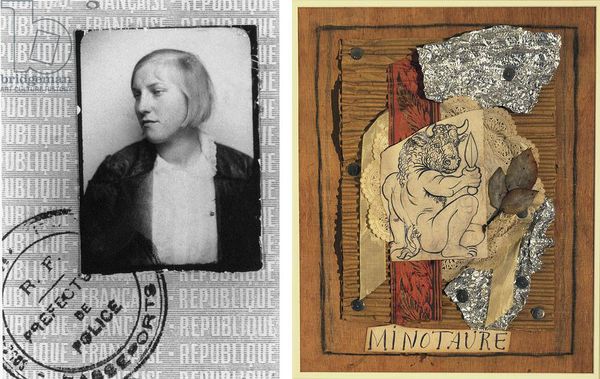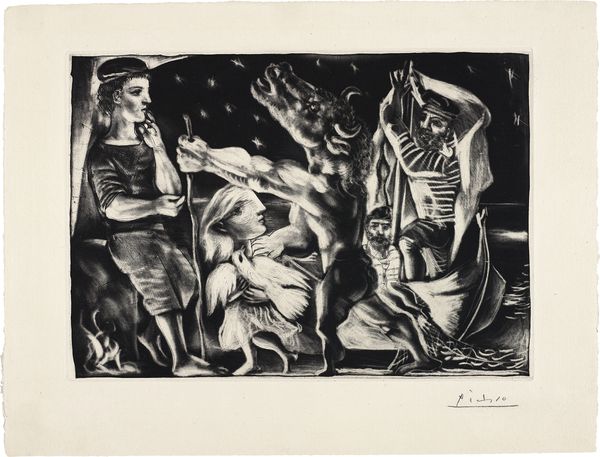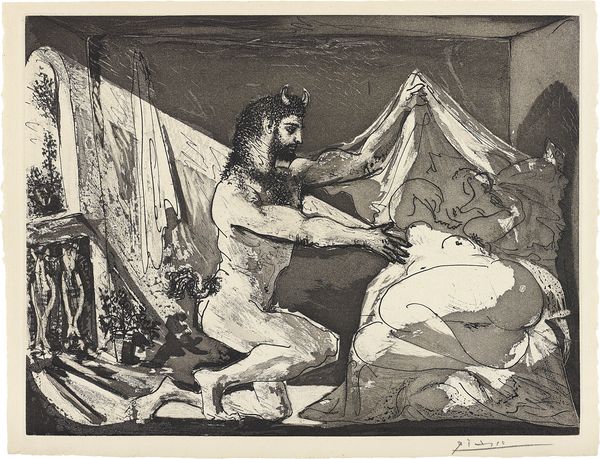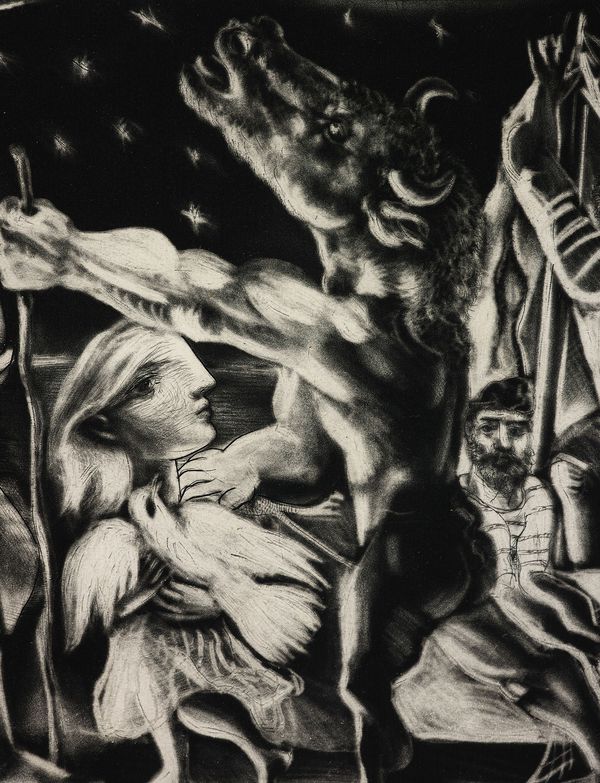Pablo Picasso Minotaure aveugle guidé par Marie-Thérèse au pigeon dans une nuit étoilée (Blind Minotaur Guided Through a Starry Night by Marie-Thérèse with a Dove), plate 97, from La Suite Vollard, 1934
Pablo Picasso produced almost 2,500 prints in his lifetime, revelling in the creative possibilities and technical challenges that the medium provided. Different stages of his career are marked by a focused concentration on individual techniques: lithography immediately after the Second World War, and colour linocut in the late 1950s. But it was etching that would both launch and close his career as a printmaker, with The Vollard Suite lying at the heart of his achievement with this medium.
The Vollard Suite, named for Ambroise Vollard (1886-1939) the great avant-garde Parisian dealer and print publisher, comprises 100 varied etchings produced between 1930 and 1937. The series illustrates a loosely woven narrative of invented characters drawn from classical mythology and brings to life the core transformative tenets of Ovid’s Metamorphoses.
Many of the early plates in The Vollard Suite focus on Picasso’s obsession with the Pygmalion relationship between artist and model, depicting scenes from his studio defined by a sparse clarity of elegant line. However, the lucid crispness of these studio scenes slowly evolves into a group of aggressively worked and re-worked plates revealing the darker, violent forces behind the seductive power of artistic creativity.

(Left) Marie-Thérèse Walter. Photo © PVDE / Bridgeman Images. (Right) Picasso, Pablo (1881-1973): Maquette for the cover of 'Minotaure' (Paris, May 1933). New York, Museum of Modern Art (MoMA). Gift of Mr. and Mrs. Alexandre P.Rosenberg.114.1974 © 2016. Digital image, The Museum of Modern Art, New York/Scala, Florence.
The works illustrated here present two of the most iconic plates from this group of mysterious and brutally passionate scenes: Minotaure aveugle guide par Marie-Thérèse au pigeon dans une nuit étoilée and Faune dévoilant une Femme.
These two plates include portraits of Picasso’s young lover: Marie-Thérèse Walter, whose mesmeric Grecian profile and athletic build were the antithesis of the bird-like features of Picasso’s ballet-dancer wife, Olga Khokhlova. His affair with Marie-Thérèse burst through the cage of bourgeois domesticity that he felt married life had become, and awoke in Picasso the unbridled lustful impulses depicted in the central section of The Vollard Suite.
Pablo Picasso Faune dévoilant une Femme (Faun Revealing a Woman), plate 27, from La Suite Vollard, 1936
The illicit nature of Picasso’s affair is palpably rendered with Faune dévoilant une Femme. In a room suffused with a stream of unearthly light, the faun (half-man, half-goat) arrives to take possession of the sleeping Marie-Thérèse. A near-pagan rephrasing of an Annunciation scene, this plate resonates with anticipation - the faun, his gaze transfixed, tentatively reaches out to touch the voluptuous female figure. The scene keeps the viewer teetering on the precipice of transformation: from studio to bedroom, man to beast, sleep to waking - and underlies Picasso’s concern with the notion of metamorphosis, of inconstant shifting from one state to another, conveyed through subtle layers of painterly sugar-lift aquatint.
The hesitant tip-toeing of the faun towards the sleeping Marie-Thérèse almost bookends with the denouement of The Vollard Suite, ushered in with the Minotaure aveugle. Triggered by a commission to provide a cover illustration for the newly launched Surrealist magazine Minotare, Picasso’s alter-ego figure of the Minotaur makes its first appearance in The Vollard Suite in May 1933. In the intervening plates from Faune to Minotaure aveugle, this motif represents the dark centre of man’s violent, irrational and lustful desires. This mythological beast is at once the monster within, but also the fighting bull of Picasso’s native Spain, whose power, pride and ferocity corresponds with the artist’s own character.
If all the ways I have been along were marked on a map and joined up with a line, it might represent a minotaur.
— Pablo Picasso
In Minotaure aveugle, the once powerful Minotaur, who grew from the hesitant faun to a figure of Dionysian proportions, is now cowed into submission. Sightless and impotent, he is led by a child-like rendering of Marie-Thérèse clutching a white dove of peace. In this plate, Picasso has plunged the scene into dramatic darkness, with vigorous scraping of the plate revealing highlights of the night stars and the soft hairs underneath the Minotaur’s upturned jaw, to create a complex visual allegory of the forces of darkness.
Pablo Picasso Minotaure aveugle guidé par Marie-Thérèse au pigeon dans une nuit étoilée (detail), 1934
The motif of a blind Minotaur was not taken from mythology, but instead invented by Picasso from his personal terror of blindness, which had followed him from his earliest days as a painter. However, the very tangible fear (and perhaps hope for salvation) expressed in this work goes beyond autobiography, evoking the wider political darkness threatening to engulf Europe with the rise of fascism in Germany and Italy.
Ultimately, Minotaure aveugle guide par Marie-Thérèse au pigeon dans une nuit étoilée and Faune dévoilant une Femme exemplify the intense symbolism and mythical power of The Vollard Suite as well as demonstrating Picasso’s superior skill and artistic vision with the medium of etching.
— Rebecca Tooby-Desmond, Phillips Editions


